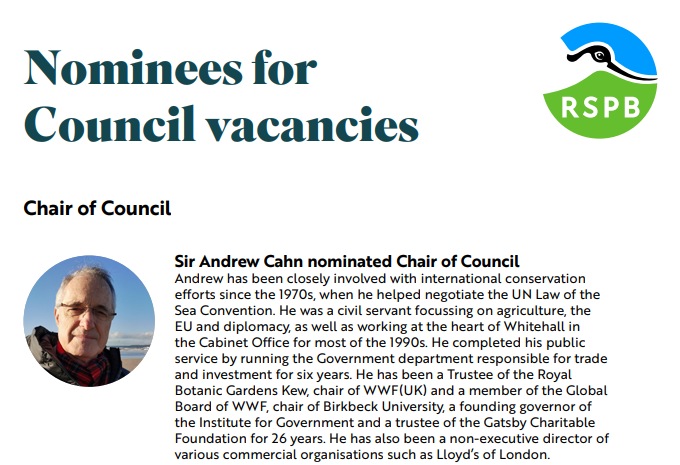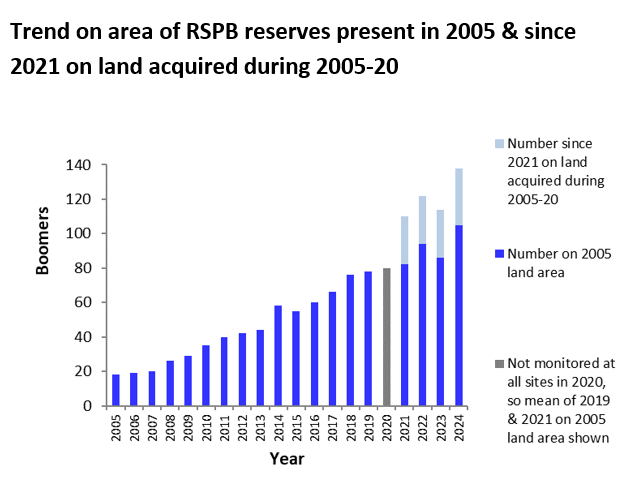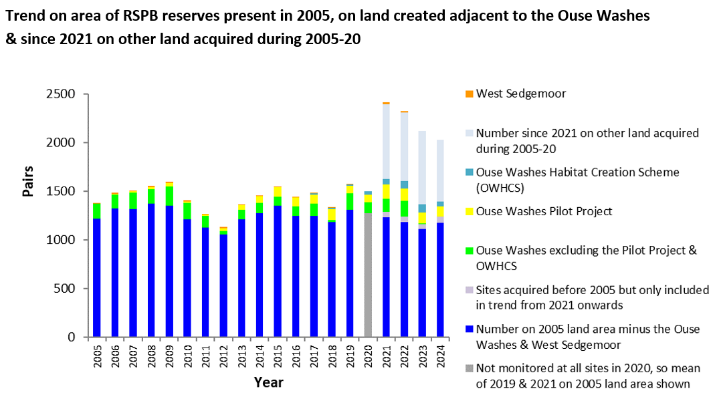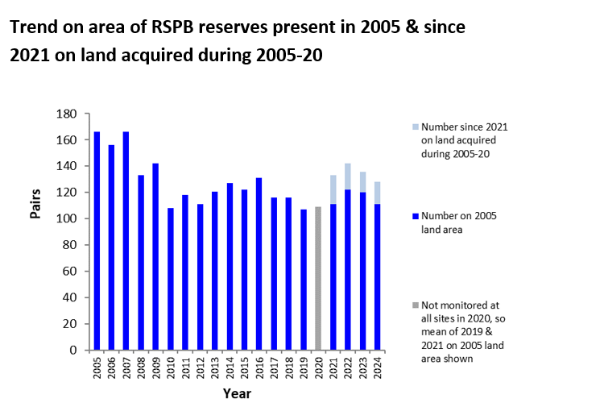
This blog follows yesterday’s in publishing the RSPB Chair’s response Yesterday Qs1-4, today Qs5-6) to my impertinent questions. This series will complete (Qs7-10) tomorrow. My questions are bold, followed by Sir Andrew Cahn’s responses in blue and my comments in green.
5. I find that almost every RSPB communication I receive is trying to get me to spend my money (on bird food, on entry to a raffle to win a house worth millions of pounds, on Christmas gifts) but not to donate to land purchases or specific conservation projects. I am surprised at this. I am one of the declining number of RSPB members who is cause-led rather than a transactional member. If I am going to give you my money, and support you in many other ways, I need to be reassured by evidence that you will turn it into more nature on the ground. I am a conservation investor looking for a conservation return on my investment.
Delivering conservation impact is our mission and remains absolutely critical to everything we do as an organisation. Our members are a varied group and want different things but I would challenge your suggestion that more and more members are purely transactional. I think the opposite is true, with a recent survey showing that more than two thirds of new members joined specifically to support our conservation work protecting birds.
We are getting better at providing different individuals with more of the things they want to see, but we accept there is still some way to go on this. Our technology teams are working on the systems that will enable us to tailor preferences for individual members much more, but this does take time to get right.
You mention the Omaze Cornwall house draw and whilst it might not be how you would choose to spend your money, tens of thousands of people did, and it raised £4.9 million for peatland restoration. All at a time when conservation needs all the attention and finance possible. We think that’s a pretty good end result.
We absolutely do run appeals for projects and recent ones have included our investigations work, the Gough Island eradication, and our response to avian influenza. We currently have a live appeal for the Orkney Native Wildlife Project and you can donate here.
Land purchase appeals are still very much on the menu too. We have grown our reserves network by some 8,500 hectares since 2017 and we have an exciting and significant land purchase appeal coming up in the New Year which I’m hopeful that you will be supportive of.
I also take your point about the things you want to invest in which brings me to your next question.
Well, we’ll have to agree to differ here because I am sure that there has been that shift from cause-led to transactional members. I base this on decades of lived experience inside and outside the RSPB which you do not have, so I feel (perhaps wrongly) fairly secure in my opinion.
The RSPB’s recruitment literature moved away from cause-led to transactional scripts from around 2012 (before the current Chief Executive was appointed) when the Communications Directorate was merged with the Marketing Directorate – in other words the people who had to raise the money were put in charge of the means of communicating to the public. From that point, the nature of people recruited to RSPB membership changed and that has implications for how the membership thinks and acts now. There are plenty of cause-led members still but our representation is falling all the time.
Now, RSPB members, even when invited to do so, are far less likely to write a letter to a decision-maker, go on a march or sign a petition. Senior members of your staff are quite often heard to say, ‘Our members don’t like that sort of thing’ but that is because you are recruiting new members with very different messages. The messages one uses to recruit members determine the members one gets, and if they aren’t recruited to a cause they won’t act as if they support that cause. Of course they will say they care about conservation and I’m sure they do to some extent, but not as much as their predecessors of 20 years ago.
The words you were given, rather foolishly, from the point of your argument, use the example of the Omaze house draw to support your case. I am very glad that it was successful in financial terms and I heard yesterday something about how the money will be spent which pleased me very much and I look forward to a public announcement in due course. However, the tens of thousands of people who supported it must have been motivated to own a big house – I rest my case! How transactional can you get? I didn’t want a ridiculously large house and so I didn’t support it but looked around, including away from the RSPB, for a cause to support.
If someone as hefted to the RSPB as I am thinks that way then you will be losing more and more cause-led members and having to unearth more and more transactional members. Is this a spiral down which the RSPB wants to travel? It has spun quite a long way down already. Of course, the ends justify the means to some extent but the character and nature of the RSPB membership is a far bigger asset than a short-term financial success. As the new Chair, I hope you to keep this in mind during your tenure.
By the way, you didn’t answer the part of the previous question about what is the profit on a £20 bag of bird food. If it is as much as £2 then the buyer is getting £18 of bird food for their £20 and the RSPB is getting £2 to invest in real nature conservation – that’s a transactional relationship. When I give RSPB or another organisation £20 I don’t want £2 of conservation work and £18 of seeds, I want as close to £20 of conservation work as possible – that’s a cause-led relationship. You are treating me as a transactional member not as a cause-led member. In the words of Julia Roberts’s character in Pretty Woman ‘Big mistake. Big mistake!’.
You say that the RSPB is getting better at putting propositions in front of supporters that are the ones that interest them but the fact that I am bombarded with emails trying to sell me bird food, and now ones that treat me as though I aspire to live in a multi-million pound house, and yet you don’t trouble me much to support conservation work persuades me that cannot be true because that isn’t how I have been treated. I know how I feel I am treated by the RSPB just as Julia Roberts’s character knew perfectly well how she had been treated.
I was an RSPB Director for 13 years and heard those same words that you have just sent to me about targeting communications so often that it is amusing to hear them a further 12 years down the track. Very few organisations have cracked segmenting their overall audience and the RSPB certainly hasn’t. After a quarter of a century you might begin to be sceptical that the answer is just around the corner and I’ll believe it has arrived when I get far fewer adverts for bird food and more appeals for land purchases and other conservation work.
8,500ha sounds like a lot but the total land area of RSPB nature reserves is 160,000ha. If I were you, I’d ask how much money did the RSPB spend, and how much land did it acquire, in the period 2007-2015 and compare that with the period you have used (2016-24). I would be interested in the answer but I’m not asking you to tell me, but I think you should know for your own education and background knowledge.
Your recent survey which showed that members want to support conservation probably asked whether they wanted to support conservation and got the answer yes. What else would people say?
I find this answer the most unconvincing of all of your responses to me but may I repeat my thanks for the speed, detail and openness of your reply. Let’s move on to …
How many Lapwings, Bitterns and Roseate Terns nested on RSPB nature reserves in each of the last 10 years? These figures (and those for many other species) used to be publicly available but I can’t find them anywhere now. Are these figures known to the RSPB or has their collection ceased or gone into decline? This type of conservation information is what a conservation investor, like me, would be keen to see and on which investment decisions could be made but they are also obviously and fundamentally the type of information on which the RSPB should be judging its own success. They ought therefore to be close at hand. They ought to be (and were) figures on which Council made decisions about future conservation investment.
Our science and our monitoring work are vital to us and our decision making. We keep a close eye on how species are doing on our reserves through annual reporting and this informs our management plans and the decisions we make as an organisation. If we are not delivering for the wildlife on our reserves and threatened species elsewhere then we really aren’t doing our job properly.
As to your second point, do we communicate these successes (and sometimes failures) in the best way? Perhaps not. Historically, the RSPB published an annual glossy reserves report at quite a high cost, and we found that it wasn’t being as well used as we would like. We still collect the data from our reserves but have been using the information to create a programme of stories that are released throughout the year, to try to get more regular media interest and coverage in the value of our reserves and the species stories. There has been some success with this approach, but we know that some audiences such as yourself have missed the collated report. We are currently considering options including a web-based report, and your feedback is helpful in this regard. This would sit alongside the investment we have made in new channels to tell our conservation stories which have proved popular with many of our supporters, such as weekly emails, our different social media channels and our new YouTube series.
Without the trust and investment of members like you, we would not be able to do what we do. As you know this investment often doesn’t see a quick return, the work is highly complex and demanding, and sometimes takes decades to happen. And with governments as primary players in whether we see wildlife recover, we are also not in complete control of the outcomes. But for many species we are able to produce some amazing results. As for the information on the three specific species you requested, my colleagues in the Ecology team have produced these fascinating graphs that plot the data for the last 20, or in the case of Roseate Tern, 30 years.
Roseate Tern
Sadly, you can see the effect of avian influenza in the drop in numbers in 2023, but thanks to the dedication and hard work of the team, numbers of terns have shown signs of recovery this year.

Bittern

Lapwing
We are managing to maintain Lapwing on our estate in the face of wider countryside declines. We split the monitoring for these species by habitat. That can be seen in the two graphs below with those nesting in lowland wet grassland in the upper graph and in northern fen in the lower one.


Sir Andrew, we are back to being in almost complete agreement here. I’m glad. I fully agree with your first paragraph and it pleases me to see it set out so clearly. Thank you.
Before I make some more general points I hope you and readers of this blog will forgive me if I say a little about the three species illustrated.
The Roseate Tern is one of my favourite species and means a lot to me, as it does to my friend and former colleague Euan Dunn to whom the RSPB gave the RSPB Medal this year. Euan did the fieldwork for his PhD on Coquet Island (the green bits of the bars in the graph) and studied terns including Roseates. One of my first jobs in the RSPB was providing the science to fuel a Roseate Tern recovery across the EU range (UK, Ireland, France and Portugal (Azores)) and the RSPB led a major recovery on and off our own (it was ‘our’ at the time) nature reserves. There are other graphs, for other places, for this species in which RSPB has played a major role.
The Bittern is a similar story. It, like Roseate Tern, was in decline (and we should have spotted this sooner) when I became Head of Research (what is now Director of Conservation Science) in 1992. Two biologists, Ken Smith and Glen Tyler, led the research that provided the sound basis for a recovery on RSPB reserves but also across a much wider range of sites owned and managed by other organisations and some owned by private individuals. It can truly be said that RSPB research and RSPB land management, as well as RSPB-led fundraising (including a large grant from the EU) are the reason that Bitterns are a rather familiar sight these day on many wetlands.
The Lapwing story on RSPB land is more complex but it is good to see that on the RSPB land that holds the largest share of Lapwings (compare the Y-axis legend of the two graphs), lowland wet grassland, they are holding their own so well. This is a real achievement – like most conservation these days, stopping further decline is almost as difficult as producing increases.
Let me now make those general points.
First, there is no other wildlife conservation charity in the UK who could produce data like these for their own land holding. The National Trust couldn’t and very few individual Wildlife Trusts could, let alone bring those data together for the Wildlife Trusts as a whole. National Trust and Wildlife Trusts report their successes by anecdote which is far less than how the RSPB can do it. Make the most of this! And I note that all three graphs are bang up to date with 2024 figures. This says a lot about the RSPB – actually it says a lot about how the RSPB was and what systems it set up years ago. I’m very glad to see that they still remain in place.
Second, I clearly didn’t choose these three species at random, I knew that Roseate Tern and Bittern would look good (they look great!) but I was less sure about Lapwing. There are many other species that tell good stories too, and a few where the results are less impressive. But they form a firm basis for land management, further reserves purchase and advocacy to others for some species. That the RSPB can I say ‘Look what we achieved on our own land. Others could do it too.’ is a powerful message to give funders of conservation work and government when it is thinking of grants. Hope Farm is another good non-reserve example.
Third, you anticipated my point with the first two sentences of your second paragraph – yes, RSPB should be using these graphs (or the data that underlie them) to tell stories of success (and some of limited success). I’d upgrade your ‘Perhaps not!’ to ‘Certainly not!’ but you already have the point in your head, I’m glad to see. The next time the RSPB tries to get at my money through dangling a multi-million pound house in front of me I will still ignore it but I’ll remember these graphs and smile. and it isn’t that I want the collated report (though I’d happily get one!) it is more that I want to see those data used prominently across the RSPB’s communications with me, the public, decision-makers and enemies – they tell very powerful stories.
Fourth, building on that last point, RSPB should be using these data more to quell critics. Almost every farmer I meet, and almost every shooter, tells me how rubbish the RSPB is at managing land for wildlife. they won’t just be telling me they’ll be telling the world on social media and local RSPB members at the village fete, dinner parties and at the school gate. Years ago, I had the figures at my fingertips to bat these comments away, in public and private, but they are still out there. Don’t ignore the campaign of undermining the RSPB but don’t take it too seriously either. Using hard facts like these is one useful approach. The RSPB has much of which it should be proud so it shouldn’t be cowed by its detractors. Get onto the front foot far more often.
That’s it for today, I’ll be back with the last our of your responses tomorrow. But please note that the Council Coordinator, name starts with a ‘C’, is really on the ball. I was sent the missing RSPB NPPF consultation response within minutes of yesterday’s blog going live – impressive!
[registration_form]
Thanks Mark, for pursuing and sharing this correspondence.
I’m particularly interested in Q5 about the nature of RSPB communications, the type of members it attracts, and what this says about the organisation.
Politicians respond to signals from the electorate about which issues they care about most. They, and civil servants, are happy to tie up professional lobbyists in endless talks without uch action – unless they feel or fear some heat from voters.
Arguably, the nature conservation movement’s biggest challenge is demonstrating to Government that a significant proportion of the electorate cares about saving nature. I don’t see any signs of a clear plan – ideally on behalf of the collective nature conservation movement – to address this.
The RSPB’s ‘A World Richer in Nature’ report contains some compelling conservation statistics and case studies. Throughout this report there are numerous – eminently sensible – references to actions that the governments of the UK need to take to address biodiversity declines. Plus, a cursory section on ‘The Power of People’, which calls on governments to support and empower people to act for nature – I’m not holding my breath!
Unless the demands in reports like this are supported by evidence that people really do care about saving nature, they will go largely unheeded. As have similar demands for as long as most of us can remember.
The RSPB used to be adept at supporting its professional lobbying with popular pressure – albeit with an element of ‘smoke and mirrors’. It should be leading a concerted effort by the nature conservation movement to show that people really do care about saving wildlife and the environment.
The content of their communications to existing and prospective members plays a key part in this. Plus, the signals they send through wider media activities.
If the collective body of saving nature organisations is unable – or lacks the political will – to do this, then maybe it needs to double down on land acquisition and management where it’s far easier to show a tangible link between resources in and conservation out.
Of course, the ideal solution is a combination of policy influence and action on the ground. It feels like achieving the former requires a rethink.
Or maybe there is more progress being made than is immediately apparent? I’d be happy to be corrected.
Paul – I agree with you.
Hi Mark, I too objected to the Omaze house raffle and got a similar answer to the one you got. This conspicuous-consumption-fest is exactly what the RSPB should NOT be promoting. the text of my e-mail is below:
“Dear RSPB,
I am a Life Fellow, having joined the RSPB in 1974. I was absolutely disgusted to receive an e-mail inviting me to participate in a prize draw which would give me an infinitesimally minuscule chance of winning a house in Cornwall worth £4.5M. I think the whole concept is wrong-headed and exactly NOT what an organisation like RSPB should be doing. Offering such a high-value prize, outwith most people’s comprehension, is pandering to just the attitudes we must overcome if we are to ever avert the biodiversity and climate crises.
The idea that it is desirable to own such an outrageously expensive property promotes the attitude that money is the measure of everything.
If we are to make space on this planet for other life forms and reduce our carbon footprint, we must all learn to live more frugal lives and consume less. The e-mail says that the winner could turn the property into a wildlife haven by appropriate planting etc. This raises the
question: what was on this cliff-top site before this property was built? Would leaving it undeveloped have been better for wildlife in the first place?
I notice that Omaze promise that 17% of the takings will go to RSPB, with a minimum of £1M guaranteed regardless of takings. So where does the other 83% go??? You may think this is a great way to raise oodles of cash, but I am sure I am not the only Member to be appalled at RSPB taking this fundraising route.
To show that I fundamentally believe that RSPB is doing good work and that I am prepared to give money without needing to have consumerist trinkets dangled in front of me I will donate to your Peatlands campaign (if I can find a way of doing so online).
I will be interested to hear the reasoning behind your decision to pursue this method of fundraising.”
More power to your elbow in questioning this kind of nonsense!